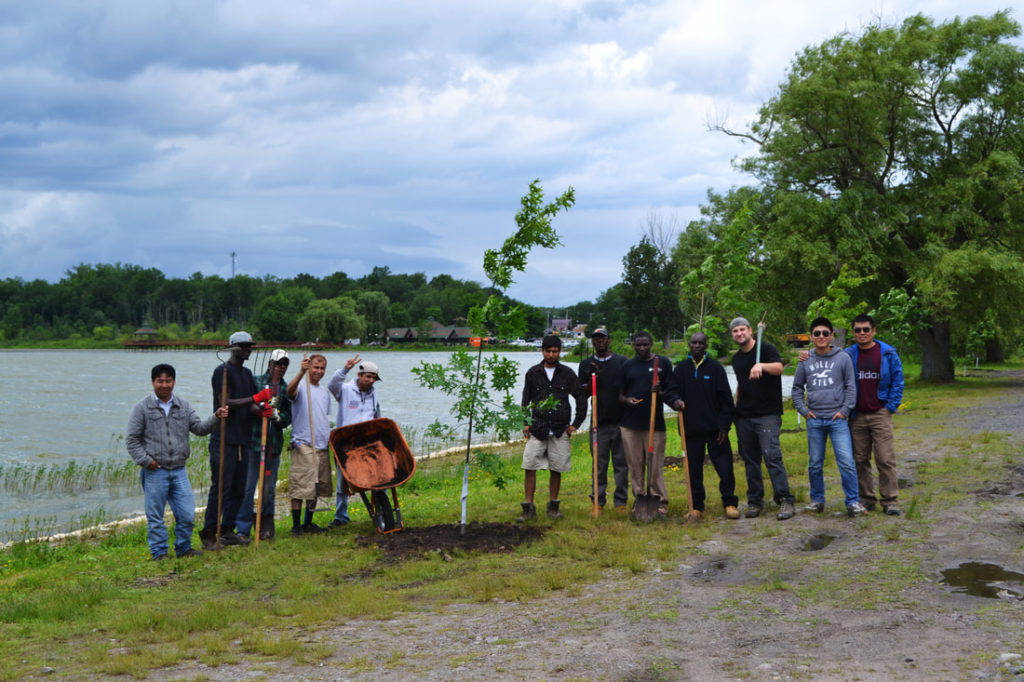Greening Brownfields
3/16/2018
By Haichao Wang

In urban areas around the country, brownfield sites pose challenges to redevelopment and resuscitation of blighted urban areas. These former industrial sites may also create environmental risks, including the potential for low-level contaminants in the soils to be swept into adjacent waterways via surface runoff or groundwater flows. These discharges aren’t directly regulated by the Clean Water Act’s permit requirements or easily captured via “end-of-pipe” controls. However, contaminated runoff from brownfields may be reduced or managed through green infrastructure. Atlantic States Legal Foundation (ASLF) is deeply engaged in green solutions to water pollution and recently applied this approach to protect Lake Ontario from brownfield runoff in Oswego County.
Oswego County contains dozens of former industrial and brownfield sites. Many are so close to Lake Ontario or its tributaries that contaminated surface and groundwater flows across these sites directly threaten Great Lakes water quality. Strategically planted trees and shrubs can help mitigate stormwater runoff and limit groundwater flow, decreasing the amount of non-point source pollution entering Lake Ontario from these sources. The newly planted vegetation provides many secondary benefits as well, helping rebuild the urban tree canopy, creating wildlife habitat, improving biodiversity in urban ecosystems, improving air quality, and building local resilience to climate change. For all these reasons, green infrastructure may be one of the most efficient and multi-functional ways to reduce the threat of contaminated runoff and reduced water quality in urban waterbodies.
In 2016 and 2017, ASLF put this theory into action, teaming with the Oswego County Department of Community Development, Tourism & Planning (OCDCDPT) to design and implement a green infrastructure response to the threats to Lake Ontario water quality posed by area brownfields. With support from the U.S. Forest Service and the U.S. Environmental Protection Agency under a Great Lakes Restoration Initiative (GLRI) grant, ASLF and OCDCDPT jointly identified eight brownfields or former industrial sites that posed significant risks to water quality in Lake Ontario. Working with Catholic Charities of Onondaga County (CCOC), ASLF planted 421 trees and 238 shrubs on these sites, which include Van Buren Park, the former Fulton Terminals, and Recreation Park in the City of Fulton and the Eastside Sewage Treatment Plant, former Hammermill site, Schuyler Street, and the Oswego Speedway in the City of Oswego. All of the species were native to New York, further enhancing the value of the project.
The work was well received by local communities and tree stewards. Site selection involved extensive public outreach. Municipal agencies, community organizations, and private entities in Oswego County, including the Oswego County Department of Buildings and Grounds, the City of Fulton Parks and Recreation, the City of Oswego Department of Public Works, Friends of Fulton Parks, the Oswego Tree Stewards; and Oswego Speedway, supported the project and offered help in both the planning and execution phases. Volunteers from Fulton and Oswego have produced labels for every tree and shrub planted through this grant and are currently helping us label the newly planted vegetation.
ASLF successfully completed the plantings in October 2017. We exceeded the proposed goal of 400 trees and 200 shrubs by more than 10%. Trees and shrubs planted through this grant, once established, will help reduce the amount of the polluted surface runoff and the load of pollutants accumulated from approximately 62 acres of land that is hydrologically connected directly to the planting areas, entering Lake Ontario and its tributaries.
We have created a digital map containing information about the locations, species, and sizes of the trees and shrubs planted through this project, which is also available online. (Click HERE to view the map.) ASLF will be organizing field trips sometime in Spring 2018 to bring volunteers and other interested people to the project sites, where they will enjoy a chance to learn about tree identification techniques, the tremendous benefit of urban forestry, and tips about tree care and maintenance.
If you’re interested in learning more about water quality protection through green infrastructure, please consider attending one of the Oswego field trips (details will be posted on-line) or contact us directly on-line. Green infrastructure is growing and ASLF is committed to helping plant the seeds!
